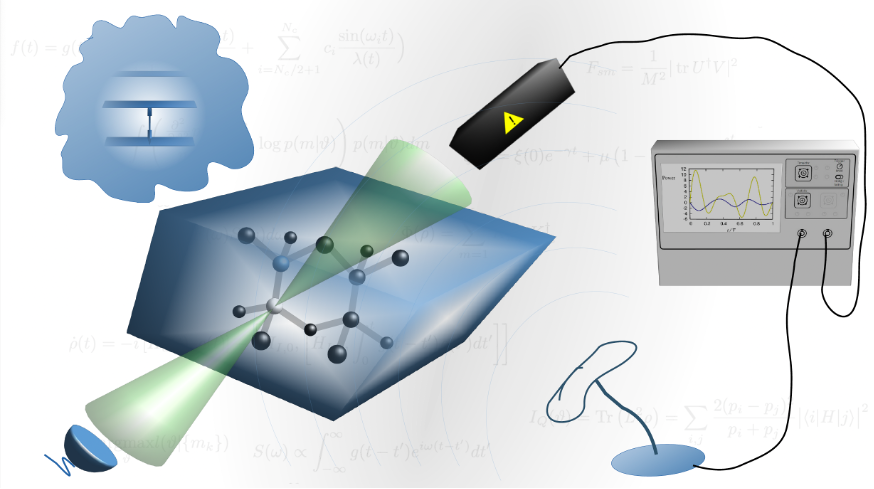Solid State Quantum Optics
In our research group we focus on the study of few-body quantum systems based on spins in solid-state materials toward quantum technology applications. Thereby, the interplay of quantum control, environment and measurements is at the heart of open problems in quantum information and quantum sensing, yet not enough is known at present.
We investigate this interplay from a theoretical and numerical perspective with a focus on the coherent and dissipative manipulations (protocols) including quantum optimal control, dynamical decoupling and measurement-based protocols. These protocols are employed in two directions: In many applications the necessary degree of control over the system can be achieved only when the interaction with the environment is mitigated by the control strategy, i.e., to achieve high-fidelity gates for quantum computing. In another scenario, small quantum systems (probes) are employed to extract information on the environment. In this case the role of the control is to encode the relevant information on the environment in the read-out of the probe.

Quantum optimal control
Quantum optimal control hat sich als vielseitiges Werkzeug erwiesen, das den Übergang der Quantenphysik von der Beobachtungs- und Beschreibungsphase zur Konstruktionsphase verbessert, indem es die Dynamik eines Quantensystems durch ausgeklügelte externe Antriebspulse, z. B. elektromagnetische Felder, steuert. Unsere bevorzugte Methode ist der dCRAB-Algorithmus (dressed chopped random basis), der günstige Konvergenzeigenschaften mit der Möglichkeit verbindet, Einschränkungen für das Steuerfeld einzubeziehen, und sowohl im geschlossenen als auch im offenen Regelkreis betrieben werden kann. Eine detaillierte und kalibrierte numerische Simulation des Quantengeräts ermöglicht es, die erforderlichen Steuerimpulse numerisch vorzubereiten und sie dann im Labor anzuwenden.
Closed-loop control
In many cases even a very detailed numerical simulation cannot model faithfully enough a quantum device that has to be optimized. In such cases, measurement feedback is needed in order to design control pulses that steer the device with the desired precision. Together with our experimental collaborators we use the open-source software Quantum Optimal Control Suite (QuOCS) for measurement-based, closed-loop, pulse optimization.
From a theoretical point of view, we study and design measurement protocols tailored to the experimental setup in order to obtain the most efficient closed-loop optimization protocols.
Control of open quantum systems and quantum sensing
Various control pulses acting on the system and/or its environment allow to tune the system-environment interaction. The efficient description of these driven open systems typically requires approximations tailored to the regime of interest (i.e., certain constraints on the drive or assumptions on the environment). For quantum sensing, we consider a system (sensor) that interacts with the environment in a desired (signal) and undesired, deleterious (noise) way.
To operate the quantum sensor, the effect of the noise, e.g., from neighboring spins, has to be suppressed and the effect of the signal (typically external to the sensor device) has to be extracted. For this aim we apply methods of optimal control, measurement-induced control, and dynamical decoupling to engineer the system-environment interactions. For quantum computing applications, instead, understanding and characterizing the interactions of the system with the environment is crucial to design high-fidelity gates in the presence of noise.
Colour Centres
Atomic defects in crystals, such as nitrogen vacancy (NV) centers in diamond, where two carbon atoms of the diamond crystal are replaced by one nitrogen atom and one vacancy, are a unique platform for the control of single electron and nuclear spins - even at room temperature - in solid state devices. A free electron of the colour centre and surrounding nuclear spins can be manipulated with lasers and electromagnetic fields in the radio-frequency and microwave domain.
NV centers in nanodiamonds are a leading platform in quantum sensing. Due to the good optical properties, especially group-IV defects like germanium or tin vacancy centres are also studied for applications in quantum communications, such as quantum repeater devices. Such optical links could also be a pathway to build scalable quantum computing devices based on colour centres.
